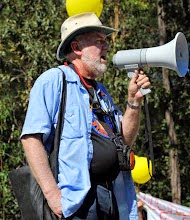Session 1 The military facilities
In the
1980’s I lived in Alice Springs and worked
with Aboriginal people in various roles.
In
contrast the staff of Pine Gap was housed in a different part of town with all
the mod cons of middle class suburbia including sprinklers for their front
lawns.
The disparity
of treatment between our indigenous people and the staff of Pine Gap was part
of what drove me to question the role of the bases and finally to join the
Anti-Bases Campaign.
US military facilities in Australia
The
Anti-Bases Campaign defines a base as any land or facility that is set aside
for the use of the US Australia Alice Springs to much smaller
facilities.
A
large percentage of Australian bases have been and are part of what is called
4CI, command, control, communication, computer and intelligence. To these have been added training,
battlefield, and logistics bases and now a troop base.
As the
technology of war grew Australia Australia US Middle East oil fields to far the
far north of China
The US
Intensification
At
that time he announced that the focus of the US Asia and the Indo-Pacific regions. It was clear to all
commentators that China
This US Darwin Australia
The bases
and the stationing of foreign troops in Darwin
Security
comes from having food, employment, housing and education. Reliance on ever
increasing numbers of increasingly sophisticated weapons robs our people and
the people of nearby states of all those things that engender security.
Tertiary
education was raided when money was needed for the Gonski reforms while at the
same time the military was awarded a funding increase in the latest budget.
Full knowledge and concurrence
Minister
Stephen Smith recently described the Australian Government’s relationship with
US military facilities on our soil as “Full knowledge and concurrence”. This is simply unbelievable.
Negative impacts
This
secrecy and lies are an example of how the existence of the US US
Aboriginal
rights are undermined. The use and abuse of the traditional lands of indigenous
people is based on the military’s view of Aboriginal lands only for their
potential to provide training ranges and military bases,
While
$25 billion is spent annually on the military, funding for indigenous health,
education, job creation and other services is woefully inadequate.
Services
that our community has a right to expect – public health, public housing and
much more – are painfully underfunded while exorbitantly expensive white
elephants like the F-35 strike planes stay on the shopping list.
The US
We must
recognise too that policies resulting from Australia Australia
As
militarism flourishes, the democratic rights of our community are also under
threat. We only have to look, for example, at the raft of recent ASIO and
associated legislation and the new laws to protect “communications facilities”
– another polite term for the bases.
It is
beyond question that money invested in civilian projects creates far more jobs
than the same funding spent on the military.
The US
military’s list of chemicals toxic to humans and to land and marine life is a
long one – depleted uranium, red and white phosphorous, cadmium and lead, to
name just a few.
The
National Cancer Institute stated: “The military is a major source of toxic
occupational and environmental exposures that can increase cancer risk…”
For
over a decade the US North West
Cape
Resistance
The
bases have been resisted right from their start of their introduction into Australia
The
Australian Government knows this and uses secrecy, disinformation and language
to protect the bases. They are never “bases” -- joint facilities has a better
ring to it. The US Australia Darwin
There
was resistance in the 60’s and 70’s but it grew in the 80’s when Foreign
Minister Hayden admitted that the bases made Australia
In
1983 a large women’s camp was established outside Pine Gap, and this was
followed some years later with formation of the Australian Anti-Bases Campaign
Coalition (anti-bases for short).
Anti-Bases
has organised protests at US facilities, against war games, in solidarity with
indigenous people across the Pacific, against exorbitant military spending and
on other issues and continues to organize and agitate for the removal of US
bases from our soil.
Anti-bases
has a commitment to always seeking permission from indigenous elders for our
protests and Aboriginal cultural and religious rules are respected. We charge
rent for the use of the land – a small symbolic sum each day from each
protester with the money given to a local Aboriginal organization. We have
always tried to have indigenous speakers at our actions and we have funded
visits by indigenous representatives from Kanaky (New Caledonia Bougainville ,
Hawaii Philippines Guam .
The
anti-bases campaign has recently been at the forefront of promoting and
encouraging a new configuration of forces to oppose the base in Darwin Asia and the Indo-Pacific by the Obama regime.
We
have contributed to the establishment of the Independent and Peaceful Australia
Network (IPAN) which has branches in most Australian capitals including Darwin
It is
possible that you have not heard of either Anti-Bases or IPAN but that is
because we have a budget of around $500 while the other mob have $billions.
We
believe that the closure of these bases would be a positive step towards world
peace and disarmament and well as to the economic and social development of Australia
I have
left information on the table and I would urge you all to take some and read
it, and to become active in the fight for peace with justice.

No comments:
Post a Comment